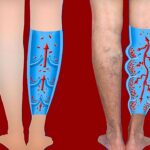Yes! Discoloration is considered a sign of Vascular Disease. A Vascular Disease occurs when the blood is not properly circulated into the body. When the Veins or Arteries are blocked by plaques and blood clots the dysfunction of circulation occurs. Discoloration happens when the veins are blocked. There are different types of skin discoloration that are related to vascular disease. Most of them are due to blockage in the veins. The most common skin conditions that are seen or related to vascular disease are:
Stasis Dermatitis
Red, itchy skin with swelling. Stasis dermatitis appears as a Red on the skin that occurs when the blood is pooling in the lower legs. Leads to inflammation, which makes the skin warm or itchy. This is commonly mistaken for cellulitis. Many times, stasis dermatitis is temporary, with proper treatment, the legs can return to normal. Treatment can be Leg elevation, wearing compression stockings, and exercising. Standing still makes the condition worse.
Hyperpigmentation
Hyperpigmentation is a dark or rusty appearance on the lower legs. The skin looks dirty no matter how much you scrub, the stain on the skin is usually from hyperpigmentation. This condition occurs due to hemosiderin stain – the leaking of iron from the vessels and turning the skin dark. It happens slowly over time. Unfortunately, hyperpigmentation is permanent. Proper vein treatment can help limit the discoloration from worsening.
Atrophy Blanche
Atrophy Blanche is a type of discoloration that is white or pale. It happens after the skin is damaged. It is the result of a healed venous ulcer or wound. This area of skin is very delicate and is prone to becoming a wound.
Rubor
Rubor is a red discoloration that is related to advancing Arterial disease and is very troublesome. If is left untreated, it swiftly moves to dead tissue in the form of wounds and gangrene. The symptom is typically foot pain. The patient may feel pain while lying in bed, walking. This is called rest pain. This needs immediate attention, and the patient should contact a Vascular Specialist/Physician as soon as possible.
Why Does Vascular Disease Cause Leg Discoloration?
Vascular disease is comprised of Venous or Arterial Disease. Chronic vein disease can cause the blood to pool in the limbs similar to Pelvic Congestion Syndrome. The tiny blood vessels on surface of skin becomes inflamed and burst, releasing iron which stains the skin. Whereas, advanced Arterial disease can cause the same type of inflammation on the surface of the skin. In severe cases of Arterial Disease, skin can also start to lose oxygen and turn blue or black.
Both types of Vascular disease can eventually lead to dry, scaly, thick, or itchy skin, or the development of slow-healing wounds called ulcers. Skin discoloration can be a warning sign of advancing Vascular Disease. See a Vascular Physician/Specialist for futher examination.
Symptoms
- Swelling in the immediate area
- Itching
- Throbbing
- Scaly and crusty sores
- Loss of hair on shins and ankles
- Thickened skin
- Varicose or spider veins
What Is the Treatment for Discoloration?
The treatment for the Discoloration are
- Radio-frequency
- Sclerotherapy
How can we Help you?
The best way to protect your skin from Vascular Discoloration is to get examined by a Vascular Physician/Specialist. If you are experiencing any signs or symptoms, we highly recommend that you schedule an appointment with a Vascular Physician/Specialist.




